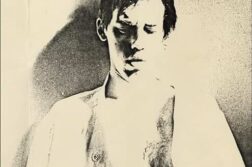THE INTERSECTION of sex and the Catholic priesthood has long been fraught, and recent scandals involving priests and choirboys have revealed to the modern public that there’s considerable overlap between the two. But clerical celibacy and its effects have been long debated. That vows of celibacy do not automatically extinguish thoughts about sex (or actions on its behalf) has been an open secret of the Church and an occasional but recurring topic of public discussion since the Middle Ages, as witness this example: the image  reproduced here was drawn in the 1330s by an Italian priest named Opicinus de Canistris. Originally from Pavia, a small university town south of Milan, Opicinus lived at the papal court in Avignon, where he worked in the scriptorium by day and created drawings by night.
reproduced here was drawn in the 1330s by an Italian priest named Opicinus de Canistris. Originally from Pavia, a small university town south of Milan, Opicinus lived at the papal court in Avignon, where he worked in the scriptorium by day and created drawings by night.
The drawing before you is likely to be one of the strangest you’ve ever laid eyes on; it will take a moment just to explain what you are seeing.
Karl Whittington is assistant professor of history of art at Ohio State University. His first book, Opicinus de Canistris and the Medieval Cartographic Imagination, was published in 2014.








Discussion3 Comments
I believe that the passions of Christ go deeper than the prohibitions laid down as dogma. I don’t believe it would have been Christs intent to preach celibacy as a form of oppression. It seems that we are missing his sole relationships with the apostles when we view it this way. It may be that to expose Christs genitalia was very much in modern day thinking with the expression “Bless My Soul” It seems that the hidden sexuality would also have to be sacred. It is interesting to inquire on what the reaction would be if we were ever truly exposed to God’s genitalia. I feel the response maybe more diverse and in keeping with the salvation we need in our climate today in the twenty first century. Surely this view of the body would not be oppressive and may even show some grace for those who feel sexuality and same sex relationships are have been exploited by a corrupt or perverted form of sin.
Am I viewing the illustrations to this article correctly or have they been printed in reverse? Spain appears to be to the East of Italy and Greece. The triangulation between Avignon, Pavia and Rome is in the wrong orientation and the abbreviated names of these cities are backwards. Even the name of Opicimus himself centered on Christs penis is only readable when viewed in a mirror!
The illustration is backwards – hold to a mirror and you can see the map of southern Europe clearly, as well as making the writing legible (albeit in the language chosen by the illustrator).